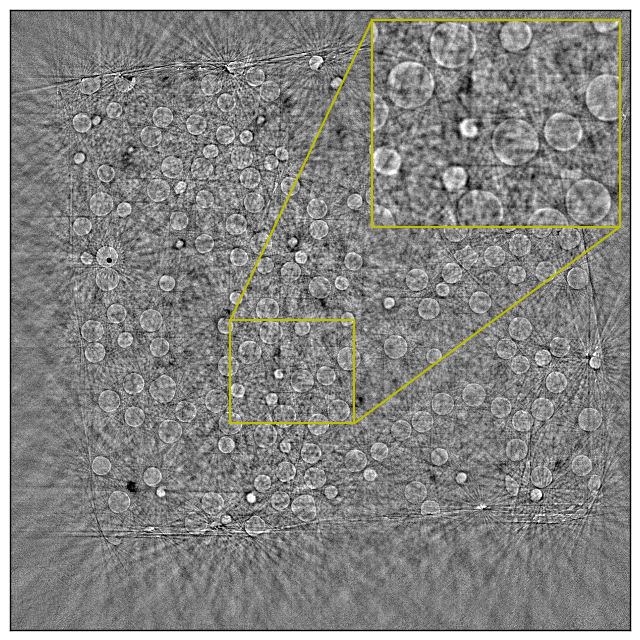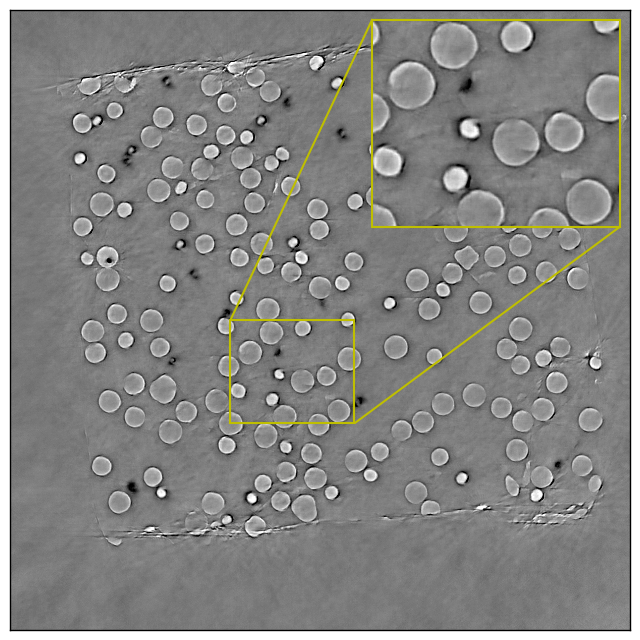If you are new to using convolution neural network for image restoration, we have some tutorial Jupyter notebooks.
Paper: arXiv:1902.07582; arXiv:1910.04081 Relevant presentation
An image quality enhancement model based on generative adversarial networks originally developed for synchrotron X-Ray tomography. It has also been used for other case like streaming tomography, the joint ptycho-tomography problem(arXiv:2009.09498). We also developed a workflow to deploy TomoGAN on Coral edge TPU (arXiv:1911.05878) which can process an image with 1k x 1k pixels in 500ms.
I also implemented the generator model based on pure Intel DNNL (MKL-DNN) and NVIDIA cudnn seperately for inference, using C++, so that you can easily integrate it in your C++ project. I will open source them soon.
To give it a try:
- download sample dataset (only need to download dataset/demo-dataset-real.h5) from Here
- install dependencies, Tensorflow(preferably 1.13 for TF1 version, 2.2 for TF2 version)
- run with
python ./main-gan.py -gpu=0 -expName=test -dsfn=dataset/demo-dataset-real.h5
Train a model with your own dataset
- one of the code-free way is to prepare a h5 file with four datasets as the sample dataset demo-dataset-real.h5. for datasets in the h5 should be named as: train_ns (noisy input) and train_gt (clean, label) for training; test_ns (noisy input) and test_gt (clean label) for validation, each dataset should have a dimension of (N, H, W) where N is the number of images.
- Best practice: always good to make sure that there is no outliers (e.g., due to bad pixels in detector) in your data.
h5dump -H demo-dataset-real.h5
HDF5 "demo-dataset-real.h5" {
GROUP "/" {
DATASET "test_gt" {
DATATYPE H5T_STD_U8LE
DATASPACE SIMPLE { ( 16, 1024, 1024 ) / ( 16, 1024, 1024 ) }
}
DATASET "test_ns" {
DATATYPE H5T_STD_U8LE
DATASPACE SIMPLE { ( 16, 1024, 1024 ) / ( 16, 1024, 1024 ) }
}
DATASET "train_gt" {
DATATYPE H5T_STD_U8LE
DATASPACE SIMPLE { ( 128, 1024, 1024 ) / ( 128, 1024, 1024 ) }
}
DATASET "train_ns" {
DATATYPE H5T_STD_U8LE
DATASPACE SIMPLE { ( 128, 1024, 1024 ) / ( 128, 1024, 1024 ) }
}
}
}
Note: with the sample dataset (128 images for training) provided here, you may not reproduce our results as it reported in arXiv:1910.04081 because we used a much larger dataset that has 2048 images. You may download the X-ray projection from TomoBank and make a reconstruction using all the projections as ground truth and a subsampled projections (every 32) as (low dose) noisy input. The dataset we provided, both norml dose (all projections) and low-dose (1/32 subsampled), were reconstructed using SIRT algorithms with 100 iterastions.
If you use this code for your research, please cite our paper(s):
@inproceedings{liu2019deep,
title={Deep Learning Accelerated Light Source Experiments},
author={Zhengchun Liu and Tekin Bicer and Rajkumar Kettimuthu and Ian Foster},
year={2019},
booktitle={2019 IEEE/ACM Third Workshop on Deep Learning on Supercomputers (DLS)},
pages={20-28},
doi={10.1109/DLS49591.2019.00008}
}
@article{liu2020tomogan,
title={TomoGAN: low-dose synchrotron x-ray tomography with generative adversarial networks: discussion},
author={Liu, Zhengchun and Bicer, Tekin and Kettimuthu, Rajkumar and Gursoy, Doga and De Carlo, Francesco and Foster, Ian},
journal={Journal of the Optical Society of America A},
volume={37},
number={3},
pages={422--434},
year={2020},
publisher={Optical Society of America}
}
As an example / teaser, a pair of noisy input and its denoised output are shown as follows,
An example input (a low-dose X-ray tomographic image ):
The corresponding output (i.e., denoised using TomoGAN):
Video clips. Left: the original SIRT reconstruction with streaming projections; Right: the corresponding enhanced reconstruction using TomoGAN in real time.






